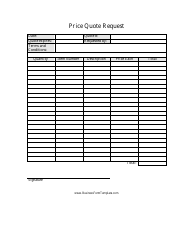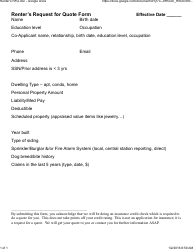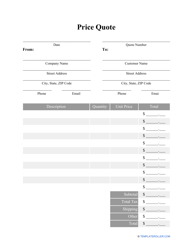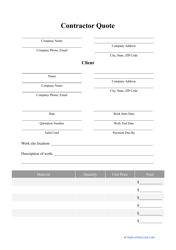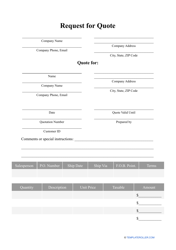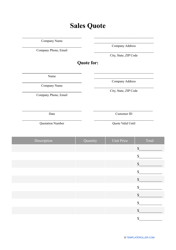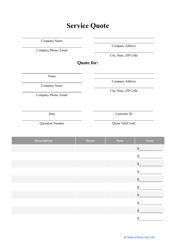How to Request a Quote: Free Request for Quote Template

A request for quote, also known as an “RFQ,” is a written request through which an individual or a business solicits certain companies or contractors to submit their up-to-date price quotes in order to select an executor for a project. Requesting a quote is crucial for businesses looking to weed out the most beneficial partners or suppliers to work with.
A quote request is usually a generic document. It will specify the type of products or services the business requires, their quantity, the overall timeframe of the project, and any other specifications. The information sent in response - including the pricing, payment terms, and potential schedule of delivery - will influence the company's bid selection. After submitting an RFQ and receiving a quote, the business will, most likely, file a proposal request (or “RFP”).
What Is a Quote?
A business quote - alternatively referred to as a “quote,” “quotation,” or “price quote” - is a document that lists the specific set prices for the goods or services a company offers. Most quotes are written but some can be made in the form of a verbal statement.
The prices on a quote are valid for a certain agreed-upon period of time and cannot be revoked once accepted by the client. In addition to the price list, a quote will usually include the following information:
- The supplier’s or contractor’s identifying information and mailing address.
- A quote number, the date of issue, and validity period.
- A breakdown of prices and the total cost of the project.
- A schedule and an estimated timeline of the project.
- Method of payment (if a deposit is required).
What Does it Mean to Get a Quote?
Quotes are a common feature of many industries. Extremely commonplace in construction, design, transportation, and various other service-based industries, quotes provide the potential customer with a detailed list of all of the various types of services a company provides. Most quotes will also feature a list of special offers, one-of-a-kind opportunities, and package deals.
If you request a price quote and accept its terms, the supplier will abide by the quoted price for the duration of the project. This helps protect your business from the fluctuating market, ever-changing exchange rates, and other unexpected problems.
How to Ask for a Quote?
Wondering how to request a quote from a supplier or contractor? An RFQ is usually sent via email and is addressed directly to the individual or business that will be providing the products, materials, or services you need. It usually makes sense to send out requests to several companies in order to compare prices and secure the best possible deal before committing to a contract.
Here’s what you’ll need to include in a request for quotation email:
- A polite introduction . Since this is simply a request for a quote from a company you haven’t previously worked with, it’s perfectly fine to start the email with “To whom it may concern.”
- The request . Start the body of the letter with the phrase “I would like to request a quote for…” before listing the products or services you are interested in.
- A description of the project and what your company does.
- If requesting a service, describe the location, the time frame, and the specific deliverables.
Here are a few tips for successfully requesting a quote from a supplier:
- Describe what you need in as many details as possible . The more information about your project you provide, the better-tailored the final quote will be.
- Keep it formal and polite . An RFP is not the most personal piece of correspondence. Chances are, the supplier is getting several of these a day.
- Be specific . You want to let the supplier know about the exact products or services you will need in order to avoid having to wade through extra or unnecessary information.
How to Respond to a Quote Request?
So what do you do if your potential clients request a quote from you out of the blue? Let’s review some potential courses of action:
- Send a quote . If the information the client provided is enough to compile a quote or estimate, send it to their email address along with a cover letter or a personalized message.
- Request more information . If the information provided is not enough or if the project will require a unique approach, you can request a phone call, call your client in for an in-person meeting, or ask any questions you need via a response email.
- Deny service . If you’re unable to fulfill the client’s request, keep an email template on hand to send as a response to their RFQ.
Related Topics:
